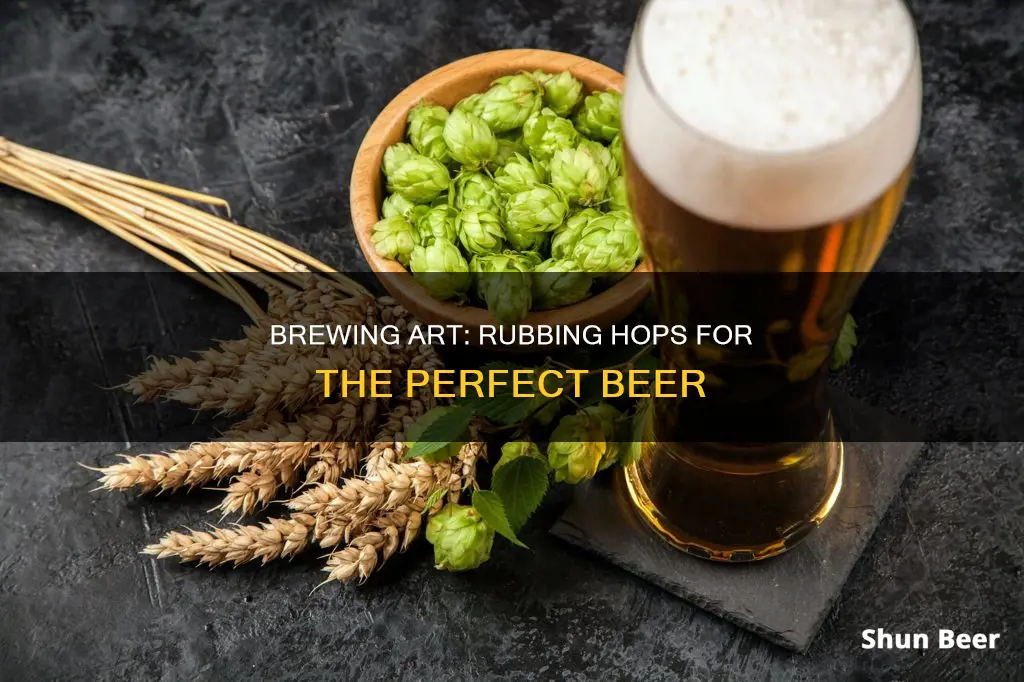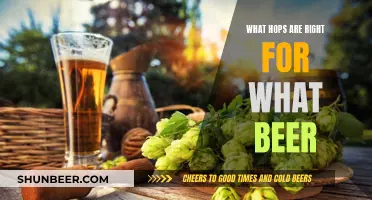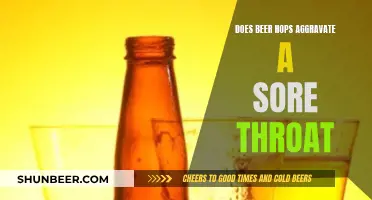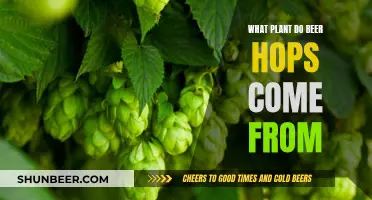
When making beer, it is important to assess the quality of the hops by rubbing and smelling them. This is because hops can turn bad due to incorrect harvesting, processing, or storage. A bad batch of hops can smell like wet hay, cheese, or old sweaty socks. The hops' aroma profile can also be affected by the time of harvest, with certain aroma compounds being released when plants are wounded, stressed, or crushed. For example, hops can smell grassy due to the release of the chemical (Z)-3-hexenal. A dry rub test can help detect these differences in aroma and allow brewers to determine if the hops are fresh or stale.
| Characteristics | Values |
|---|---|
| Reason for rubbing and smelling hops | To evaluate hops for freshness and aroma |
| How to perform a dry rub | Place hops on a clean surface, crush the hop pellets into a fine powder, rub the powder between your palms, then smell |
| How to detect fresh hops | Fresh hops will have a "popping" aroma |
| How to detect stale hops | Stale hops will smell old or stale |
| How to detect bad hops | Bad hops will smell like cheese, specifically isovaleric acid |
What You'll Learn

To check hops are fresh and not expired
Hops are flowers, and like any other plant or produce, they suffer a natural decay. They are also one of the most crucial and expensive ingredients in beer. So, it is important to check that the hops are fresh and not expired before using them.
One way to check the freshness of hops is to perform what is called a "dry rub". To do this, open a package of hops and place them on a clean surface. Crush the hop pellets into a fine powder using a spoon. Take a pinch of this powder and rub it between your palms. Then, cup your hands and bury your nose in the hops to sample the aroma.
If the hops are fresh, they should smell fragrant and fresh. If they are expired, they will smell stale, humid, putrid, cheesy, or like sweaty feet. Expired hops can also look brownish-tan.
Performing this test is important because, if you use expired hops, you risk ruining your beer. While it may not be dangerous to use old hops, it will likely ruin the flavour and aroma of your beer.
Growing Beer Hops Indoors: A Step-by-Step Guide
You may want to see also

To identify any off-flavours
When making beer, it is important to identify any off-flavours that may be present. Off-flavours are unpleasant tastes and smells that should not be present in the beer. While craft brewers aim to produce perfect products, off-flavours may be introduced during the brewing, packaging, storage, or transportation process. Off-flavours can be identified through sensory analysis, such as the hand-rub analysis method, or through more sophisticated methods such as gas chromatography and mass spectroscopy.
One common off-flavour in beer is diacetyl, which can give the beer a buttery, buttered popcorn, or butterscotch taste and smell. Diacetyl is produced by yeast during fermentation and is re-absorbed by yeast cells. However, if it is not re-absorbed completely, it can remain in the beer, resulting in an off-flavour.
Another off-flavour is dimethyl sulfide (DMS), which can give the beer a sweet corn, cooked cabbage, tomato sauce, or even shellfish and oyster smell. DMS is produced during the malting process of grains and is converted into DMS when heated. It can also be produced by bacteria that contaminate the beer.
A metallic off-flavour can also be present in beer, giving it an iron, penny, ink, or blood-like smell. This off-flavour is introduced when the beer or raw materials come into contact with poor-quality metal pipes and equipment or through packaging materials such as metal tubes, bottle caps, or kegs.
Hydrogen sulfide is another common off-flavour, giving the beer a boiled or rotten egg smell. It is produced by yeast during fermentation, with lager yeast tending to produce a greater sulphur smell than malt strains.
Isoamyl acetate is the most common ester flavour in beers and can give off a banana or pear smell. It is produced naturally during the fermentation process, and higher fermentation temperatures can result in increased production.
Light-struck is another off-flavour, giving the beer a skunk-like or freshly brewed coffee smell. It occurs when beer is exposed to transparent or green glass packaging under light, and light-coloured beer or beer with a high hop content is more prone to this off-flavour.
Oxidation is another off-flavour, resulting in the beer smelling like old wet cardboard or paper. It occurs when oxygen reacts negatively with molecules in the wort or beer, and it can be challenging to avoid since the wort needs to be aerated before yeast inoculation.
In conclusion, identifying off-flavours in beer is crucial to ensure the final product is of high quality and pleasant to consume. By using sensory analysis methods or more advanced instrumentation, brewers can detect and address any off-flavours before the beer is released to the market.
Funky Buddha Hop Gun — A Hoppy Beer?
You may want to see also

To differentiate hops from their illegal cousin, cannabis
One of the most notable similarities between hops and cannabis is their organoleptic properties, or their taste and smell. Both plants produce terpenes, aromatic compounds that contribute to their distinctive aromas. Terpenes like myrcene, beta-pinene, and alpha-humulene are found in both plants, giving them their characteristic resinous, pine-like scents. However, the terpene profile of hops used in beer can provide a more intense and diverse sensory experience.
When it comes to appearance, hops and cannabis flowers share similarities, both growing in a pineapple shape. Additionally, both plants are dioecious, meaning they produce both male and female plants, and reproduction occurs through the pollination of the female plant by the male.
Beyond their botanical and aromatic similarities, hops and cannabis have distinct roles and applications. Hops are essential in the brewing industry, prized for their bitter taste and antimicrobial properties that balance the sweetness of malt and prolong the shelf life of beer. On the other hand, cannabis has a range of applications, including medicinal therapies that utilise its cannabinoids and recreational uses valued for their psychotropic effects.
Hops in Beer, Ale, and Mead: How Much is Too Much?
You may want to see also

To check hops are not harvested too early
When hops are harvested too early, they are deprived of their awesome alpha acids. It is better to harvest hops a little too late than too early. Hops harvested too early will still feel "green" and stay compressed for a moment when squeezed. They will not have a pungent smell between cut grass and onion.
To check that hops are not harvested too early, you can perform a dry rub. Place your hops on a clean surface and crush them into a fine powder with a spoon. Take a pinch of the powder and rub it vigorously between your palms. Then, open your hands and smell the hops. If the hops smell old or stale, they may have been harvested too early.
If you try this experiment with 5-6 different packets of hops, you will be able to detect which hops are fresh and which are not. Each hop will have a distinct aroma profile. Try to pick out individual aromas as you sample each one.
However, keep in mind that just because one packet of hops smells old or stale, that may not reflect the variety as a whole. Sometimes hops get harvested at the wrong time, are processed incorrectly, or are stored or packaged improperly. It may have been a bad year for that variety or grower.
Storing Beer in the 15th Century: A Historical Perspective
You may want to see also

To check hops are not incorrectly processed
When making beer, brewers rub and smell hops to check that they are not incorrectly processed. Hops can be harvested too early or too late, and they can also be processed incorrectly. If hops are harvested too early, the crop will be lacklustre. If they are harvested too late, they can end up tasting like garlic and onions rather than citrus and blossoms. Hops can also be incorrectly processed, for example, if they are harvested at the right time but stored or packaged improperly.
To avoid these issues, brewers can perform a "dry rub" to test the quality of their hops. They do this by crushing hop pellets into a fine powder, rubbing the powder between their palms, and smelling it. This method can help brewers identify fresh "popping" hops and "stinkers". It can also help them get a good idea of the aroma profile of each hop variety, as each one will have a distinct profile. By performing this test, brewers can ensure that they are only adding high-quality hops to their beer.
Belgian Beer and Hops: A Complex Relationship
You may want to see also
Frequently asked questions
Rubbing hops is a way to test their freshness and aroma.
Place the hops on a clean surface, crush them into a fine powder with a spoon, and rub a pinch of the powder between your palms. Then, open your hands and smell the hops.
Fresh hops have been described as having a "vegetal" aroma. They can also smell citrusy, fruity, floral, herbal, spicy, resinous, or sugar-like.
If the hops smell old or stale, it could be that they were harvested at the wrong time, processed incorrectly, or stored or packaged improperly. It may not be a reflection of the variety as a whole, so it's important to test your hops before adding them to your beer.
Yes, hops can be burned or smoked, but it is not recommended to smoke them. Burning hops can produce a skunky smell similar to weed or cannabis.







